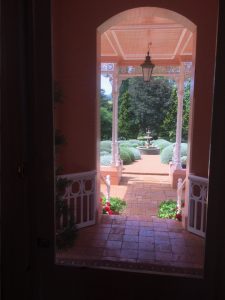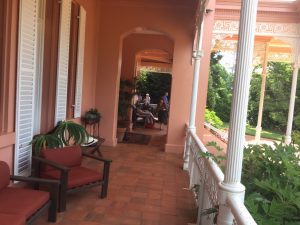
James Fairfax, former Chairman of John Fairfax Ltd, died on 11 January 2017 at the age of 83. He generously gifted the Retford Park homestead, in Bowral, NSW, to the National Trust.
For her 95th birthday celebration on 11 December 2018, Libby and Oscar drove Wilma Furlonger from Wollongong to Retford Park for a guided tour through the house and gardens, plus champagne and afternoon tea. Gil and Mic came with their three kids – Wilma’s great grandchildren; Charles came down from Sydney; and Alpha and I travelled for the occasion from Canberra.
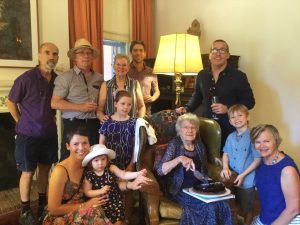
We had a lovely afternoon, with the organisers giving us extensive access to what felt to me like a recently occupied home – not just a house. Assuming that other visitors feel the same way, this means that the conversion of the homestead to a ‘house museum’ is being very effectively managed.
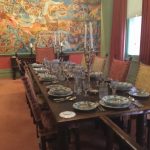
However the whole exercise seemed to me to be bathed in irony. The gauche residential development stands cheek-by-jowl with the gardens and stables of the old house; on the guided tour inside I had a strong sense of the elite company the rooms have kept, and a vague feeling of unease about not actually knowing who all these original visitors were and what they represented.
But for me the strongest sense of irony came from the total absence of reference to changes in Australia’s media landscape that are centred around the likely loss from it of the Fairfax name and brand.
The word ‘Fairfax’ hung in the air, but despite (or perhaps because of) the ongoing corporate developments, there was no mention of them. Indeed the topic of journalism scarcely came up at all, strengthening the sense that by coming in to Retford Park one had crossed back into a world that no longer exists. It was a world without social media; with slow communications and information exchanges normally characterised by parochialism and by local language and personnel, not global entities.
This previous world was one in which companies such as Fairfax prospered because of the classified ads ‘rivers of gold’, now dried up by their diversion upstream to online copy.
"Illustrating the maxim that sometimes your greatest strength can be your greatest weakness, Fairfax failed to protect its classified advertising revenue when the internet arrived and tore apart the print media’s longstanding business model. The elegantly compiled bundle of news, entertainment, service information and advertisements that was the twentieth century newspaper, was unstitched by the internet, which enabled the creation of standalone websites meeting customers’ individual needs. By the mid-2000s, if you wanted to hunt for a house or a car or a job you could do that for free. Instead of wading through pages of newsprint, you could narrow your search and quickly turn up precise information. The new online classified advertising sites could undercut Fairfax’s rates because they were in that business only and so had none of the other costs associated with gathering and distributing news." (Matthew Ricketson in the Sydney Review of Books, 19 November, 2013.)
One needs to resist a misty-eyed view of the way the world and its media used to be; but the absence of Fairfax is symptomatic of massive changes in the ownership and management of information and news that should concern everyone.
The name Fairfax is inextricably linked with public interest journalism – that is, “journalism that keeps a watching brief on society’s main institutions”. Most people living in Australia with any connection to current affairs and politics, particularly if they live in the Eastern States, have treasured the Fairfax mastheads and brands: the Melbourne Age, the Australian Financial Review and the Sydney Morning Herald. How odd, then, to spend the afternoon with James Fairfax and to have no mention of that brand or of its recent absorption into Nine Entertainment.
How is this possible? How did James, whose home this is, fit into the business? What would he have thought of the $3 to 4 billion takeover by Nine Entertainment? Should I ask someone on-site here what the Retford Park view is of the approval of the takeover just this month [December 2018] by the Federal Court?
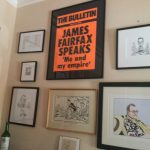
No, don’t ask. Our visit concerns a philanthropist and his art works, not the altered political and media landscape out beyond the topiary hedge.
Ironic or not, James Fairfax’s wish that the Retford Park homestead “should be preserved for the enjoyment and benefit of future generations, particularly those of the local district” is now being put into operation, thanks to the local branch of the National Trust Australia (NSW). [www.nationaltrust.org.au/places/retford-park/]
The house at Retford Park was built by Samuel and Jane Hordern in 1887 on land promised to Edward Riley Senior by Governor Macquarie in 1821. (The motto of the Anthony Hordern and Sons department store: “While I live, I’ll grow”.)
James Fairfax bought the property in 1964 “and began to turn it from an agricultural property to a gentleman’s residence”.
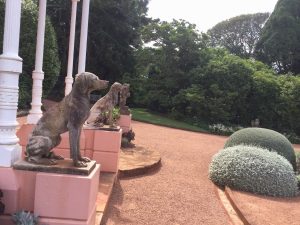
Driving up the gravel road to the house from the bitumen, the view is dominated by the residential property development springing up aggressively on part of the 120-hectare Park estate. The new houses seem to breast-beat about their size and presence, rather than peep modestly at visitors over the hedge as one wishes they might. (This disappointment is allayed when one hears that some of the costs of preserving the main homestead in perpetuity for the community are to come from this residential development.)
Our family party was about one third of the total group gathered for the tour last Saturday. The volunteers and National Trust managers gave us a conscientious welcome on a warm day, led by Scott, who was the tour leader and who was kind enough (and well enough briefed) to specifically acknowledge Wilma and her 95th birthday in his spiel.
With the group inside and in-tow Scott introduced us to each of the rooms, both downstairs and up, and focused largely on the life-size reproductions on the walls of selected pieces from James Fairfax’s art collection. As part of what was described as “a unique opportunity to experience museum-quality prints in the 19th-century mansion”, the artworks were hung in the particular places in which the Master of the House liked to have them, and together with the house’s collection of (original?) furniture and decorative arts.

There were nineteen life-size reproductions of works by artists such as John Olsen, Charles Blackman, Tony Tuckson, Fred Williams, Frederick McCubbin and Russell Drysdale. James Fairfax donated the originals to the National Gallery of Australia under the Cultural Gifts Progam which made them eligible as tax deductions. The works on show included Sunset glow (Frederick McCubbin, 1884), Anteroom (Charles Blackman, 1963), The countrywoman (Russell Drysdale, 1946) and Water pond in a landscape 1 (Fred Williams, 1966). The curatorial staff of the National Gallery of Australia had assisted with the recreation of the works and the in-house exhibition.
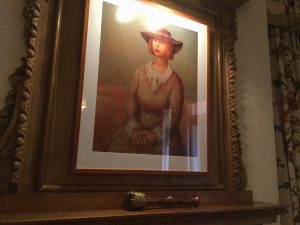
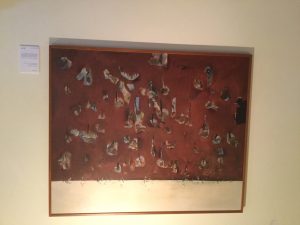
James was the eldest son of Sir Warwick Oswald Fairfax, and was on the Fairfax Board from 1957 until 1987. He was Chairman from 1977 to 1987, during which period his half-brother ‘young Warwick’ launched his ill-fated takeover of the company. In 1987 James sold his share of the business to Warwick.
It has been said that after that, at the age of 54, for the first time in his life he was free.
James Fairfax owed his fortune to the publishing company founded by his great-great-grandfather. But for Wilma’s birthday celebration we were in the presence of a man of fine art and public generosity, not politics and journalism.
